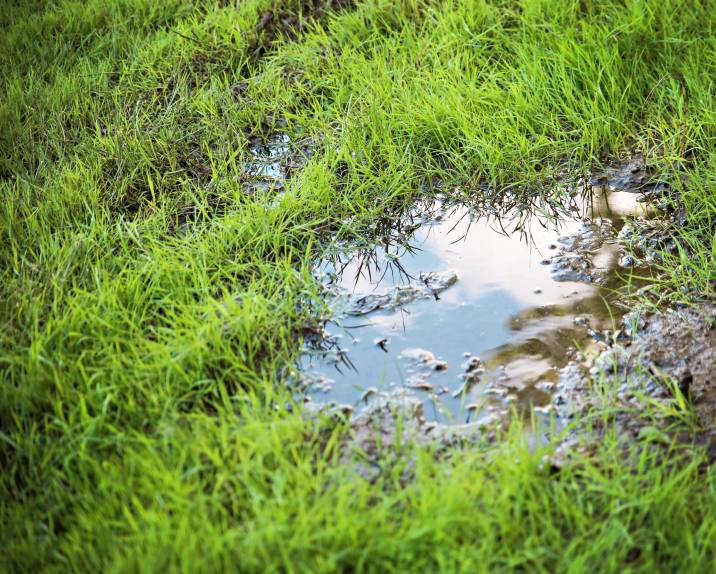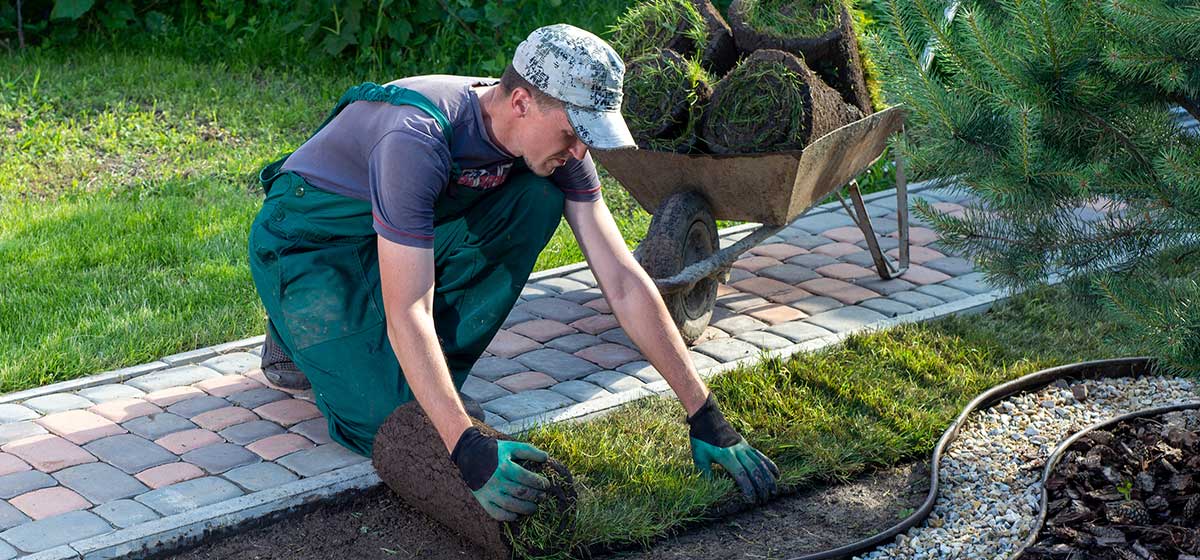
- Home/
- Guides/
- Lawn Mowing/
- How to care for your lawn after heavy rain
How to care for your lawn after heavy rain
Last Updated on
Grass can die from too much water. Lawn care might be easy if you consider yourself someone with a green thumb. But what if heavy rain severely damages your lawn? Water from floods and heavy rain cause sediment buildup, fungal diseases, icky moss, and weed infestation.
Fret not, though; here are a few nifty ideas on lawn care after heavy rain! We’ll discuss flooded lawns and how you can restore them.
Signs of a water-damaged lawn
When you deem it safe to go outside, check your property for water damage. It isn’t always easy to spot, even on lawns. With that in mind, here are five things you need to watch out for:
Runoff
 Runoff is pretty common in over-watered lawns. For example, after a storm, you might see streams of water flowing through your yard down to the pavement. When this happens, it probably means the soil has already been saturated with water. Runoff is detrimental to lawns because it washes away plant nutrients and weakens roots.
Runoff is pretty common in over-watered lawns. For example, after a storm, you might see streams of water flowing through your yard down to the pavement. When this happens, it probably means the soil has already been saturated with water. Runoff is detrimental to lawns because it washes away plant nutrients and weakens roots.
Very soft grass
 Give your lawn a step test to check if it’s water-damaged. Healthy lawns typically provide soft pathways in front yards. But if you step on your lawn gently and the turf feels too squishy, it needs immediate care. Squishiness can indicate sediment buildup, which is a combination of dirt and waste from neighbouring areas.
Give your lawn a step test to check if it’s water-damaged. Healthy lawns typically provide soft pathways in front yards. But if you step on your lawn gently and the turf feels too squishy, it needs immediate care. Squishiness can indicate sediment buildup, which is a combination of dirt and waste from neighbouring areas.
Weed growth
 Say you don’t find your lawn squishy, and there’s no runoff. Another easy-to-spot sign that your lawn is water-damaged is weed overgrowth. Lawns saturated with water are not ideal for healthy grass (the kind of grass you want to grow on your turf), but they’re breeding grounds for weeds. Floodwater weakens crisp lawns, making it easier for weeds to smother them.
Say you don’t find your lawn squishy, and there’s no runoff. Another easy-to-spot sign that your lawn is water-damaged is weed overgrowth. Lawns saturated with water are not ideal for healthy grass (the kind of grass you want to grow on your turf), but they’re breeding grounds for weeds. Floodwater weakens crisp lawns, making it easier for weeds to smother them.
Fungus and moss growth
 Aside from weeds, fungus indicates water damage. If you notice mushrooms popping up across your lawn, immediately act on it. Remember that mushrooms, particularly those growing in dirty or polluted areas, can be hazardous to pets and children. As for moss, it might not be toxic. However, it smells pretty bad if you leave it alone.
Aside from weeds, fungus indicates water damage. If you notice mushrooms popping up across your lawn, immediately act on it. Remember that mushrooms, particularly those growing in dirty or polluted areas, can be hazardous to pets and children. As for moss, it might not be toxic. However, it smells pretty bad if you leave it alone.
Thatches and bugs
 Thatch buildup or the accumulation of decomposed plant materials is a clear sign that your lawn has water damage. Thatches are great homes or hiding places for bugs and their larvae, protecting them from external threats, like sunlight and predators. Thick layers of damaged grass can even shield them from pesticides.
Thatch buildup or the accumulation of decomposed plant materials is a clear sign that your lawn has water damage. Thatches are great homes or hiding places for bugs and their larvae, protecting them from external threats, like sunlight and predators. Thick layers of damaged grass can even shield them from pesticides.
So how do you take care of your lawn?
Once you’ve detected water damage on your lawn, it’s time to address it. Here are some simple solutions before seeking professional help:
Step 1: Aerate your lawn
 Aeration involves extracting cores of soil, thatch, and grass from the surface of your lawn. This allows nutrients, water, and air to penetrate the soil, reducing compaction between sediment particles. Basically, aerating your lawn after heavy rain helps it breathe again.
Aeration involves extracting cores of soil, thatch, and grass from the surface of your lawn. This allows nutrients, water, and air to penetrate the soil, reducing compaction between sediment particles. Basically, aerating your lawn after heavy rain helps it breathe again.
You can aerate your lawn by making or poking small holes in the soil with pointed objects, such as pitchforks and aerator boot attachments. But the best method is to use a core aerator, a device that extracts soil plugs from the soil with its tines or hollow spikes. Remember that renting a lawn core aerator is better than buying one since you don't need to aerate your lawn frequently.
If it starts raining again while you're aerating your lawn, don't worry. You can still do it when it’s drizzling. On the other hand, aerating during heavy rain is risky because you might compact the soil even more. You'll encounter the same issue when aerating muddy earth. Thus, it's wise to be up-to-date on weather forecasts and strategically plan your lawn aeration schedule.
Mowing after rain can be tricky, especially if your lawn mower isn’t in top shape. Before tackling your lawn, make sure your equipment is in good condition by booking a lawn mower service near you.
Step 2: Mow your lawn when it’s dry
 If you’re thinking of mowing your lawn while it’s still very wet, think twice. It’s particularly risky when using an electric mower with an extension cord. Exposing the wires to moisture damages the machine and leads to electrocution. So wait until the soil and grass become dry enough for your safety. After light showers, it takes four to five hours for the grass to dry.
If you’re thinking of mowing your lawn while it’s still very wet, think twice. It’s particularly risky when using an electric mower with an extension cord. Exposing the wires to moisture damages the machine and leads to electrocution. So wait until the soil and grass become dry enough for your safety. After light showers, it takes four to five hours for the grass to dry.
You need to wait at least a day after heavy rain before cutting the grass. Well-cut grass blades are almost perfectly vertical. Wet lawns are heavy, so their grass blades lean towards the ground. As your yard begins to dry, some of the blades will straighten, resulting in smoother mowing. But other grass blades might circumvent your mower because of water damage. If you insist on mowing or cutting wet grass, be prepared to deal with an uneven lawn.
If your lawn mower has been damaged after heavy rain, getting it serviced is crucial. Book a professional for lawn mower repair near you to ensure your equipment is working efficiently before mowing your lawn.
Step 3: Nourish your lawn with fertiliser
 Feeding your lawn should come after mowing or when the grass is freshly cut. Fertiliser is critical if you want to grow and maintain a verdant lawn. You can choose between organic and synthetic fertilisers. Organic fertilisers are made from animal or plant products, have more nutrients, and are good for the environment. On the other hand, synthetic fertilisers have fewer nutrients but work faster on plants. If you don't use them correctly, you might damage your lawn's roots.
Feeding your lawn should come after mowing or when the grass is freshly cut. Fertiliser is critical if you want to grow and maintain a verdant lawn. You can choose between organic and synthetic fertilisers. Organic fertilisers are made from animal or plant products, have more nutrients, and are good for the environment. On the other hand, synthetic fertilisers have fewer nutrients but work faster on plants. If you don't use them correctly, you might damage your lawn's roots.
Rainwater gives your lawn some nitrogen, improving its overall health. Wait for a day or two after rainfall before applying fertiliser. There won't be pools of water at this time, but the ground will still be moist. It’s best to fertilise lawns on sunny days because sunshine is essential to photosynthesis, improving the fertiliser and encouraging healthy growth.
Regular mowing is key to maintaining a healthy lawn, but if your mower isn’t cutting properly, it may need a tune-up. Find trusted lawn mower repair specialists to diagnose and fix the issue before your next cut.
Step 4: Seed your lawn
 When worse comes to worst and you find some bald patches on your lawn, it might be time to start anew and reseed it. Adding a mixture of soil and sand helps prepare the area where you intend to sow grass seeds. If gutters or drains lead to your lawn, check them for water buildup, which might flood your yard again after heavy rain. Cleaning up fallen leaves and removing other garden waste will help, too.
When worse comes to worst and you find some bald patches on your lawn, it might be time to start anew and reseed it. Adding a mixture of soil and sand helps prepare the area where you intend to sow grass seeds. If gutters or drains lead to your lawn, check them for water buildup, which might flood your yard again after heavy rain. Cleaning up fallen leaves and removing other garden waste will help, too.
If you notice that rain puddles take longer to drain, try making some channels or runoff points, especially if your lawn doesn't have slopes. These direct the water to other areas of your yard and give the seeds some breathing and growing space.
If your mower isn’t starting or cutting grass evenly, it might be time for a repair. Connect with reliable Taskers offering lawn mower maintenance and repairs to keep your lawn looking great.
Restoring your lawn after heavy rain
Overall, restoring water-damaged lawns isn’t simple, but following these steps can lessen the burden. If your home interiors are also damaged, taking care of your lawn might seem too much. Thankfully, Taskers can do the job for you. Lawn maintenance takes time, so if you have other urgent problems to solve after a storm, rest assured that you can seek professional help.
A well-maintained lawn starts with properly working tools. If you’re struggling with a faulty mower, check out lawn mower servicing and repairs to get expert help in keeping your mower in top shape.
Stay safe!
FAQs
Not necessarily. Rain nourishes lawns, but grass can’t survive beyond four days once submerged. Heavy rain also causes soil erosion, which is detrimental to seedlings.
Yes. Brown lawn spots could signify the need for more water, but the opposite might also be true. Excess water permeates the soil, blocking the flow of air and nutrients. So if your lawn seems too dry, don’t rush to water it.
Yes! If you own a ride-on mower that needs fixing, Taskers can help troubleshoot and repair issues such as battery failures, belt replacements, or transmission problems. Simply specify that you need ride-on mower repairs near you when posting your task to get the best service.
Find lawn mowers, fast
Find a lawn mower
Related articles
Related price guides

How much does lawn care cost?
Read more








